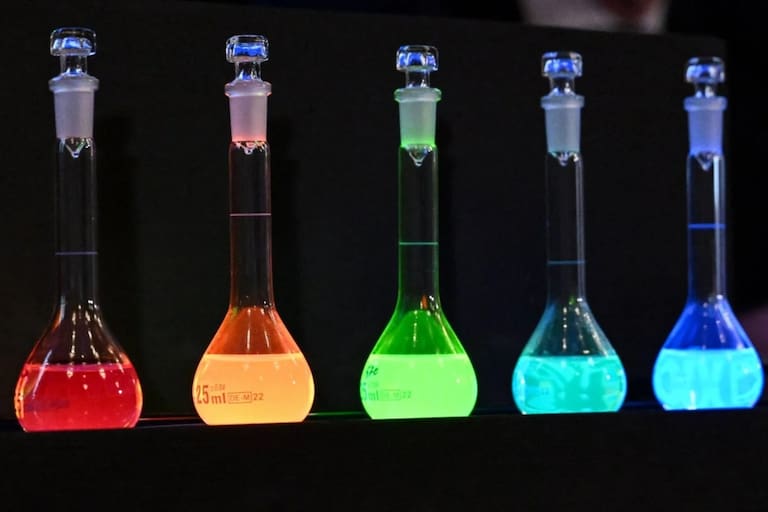the Quantum dots They are the smallest components of nanotechnology, very small, only a few millionths of a millimeter. They are artificial structures created in the laboratory from semiconducting materials, which are also known as nanocrystals. Its size is so small that its qualities are determined by phenomena of a quantum nature.
Owns Unique optical and electronic propertiesIncluding the ability to transfer electrons and emit different colored lights when stimulated with light or electricity. The smallest ones are blue, the largest ones are yellow and red.
His discovery and synthesis have been recognized with Nobel Prize in Chemistry 2023which awarded Monge Boundy, Louis Bruce and Alexei Ekimov for their work in this field.
The strange properties these nanocrystals have A revolution in commercial products Such as television screens or LED lights, and are used in many scientific disciplines, such as physics, chemistry, or medicine, where they have begun to be used in experimental cancer treatment.
These small structures “It is able to confine electrons to tiny areas, thousands of times smaller than the thickness of a human hair.”explains David Sanchez, a researcher at the Institute for Interdisciplinary Physics and Complex Systems (IFISC-CSIC-UIB), based in Palma de Mallorca, in Spain.
In nature, electrons are confined within atoms, but they are difficult and expensive to manipulate. “Thanks to quantum dots, Electrons can be trapped to make them easier to study. Hence, quantum dots are called “artificial atoms.”
Physicists have long known that, in theory, nanoparticles can have size-dependent quantum effects, but it was nearly impossible to sculpt such small particles, so few thought this knowledge could have practical applications.
In 1937, physicist Herbert Froehlich had already predicted that nanoparticles would not behave like other particles, But they will do it differently. In this way, he explored the theoretical consequences of the famous Schrödinger equation, which suggests that when particles become very small, there is less space for the electrons of the material, and so they are squeezed together.
The result of this, Frolik concluded, would be a radical change in the properties of matter. This is known as “quantum effects.” They test our intuition. However, its application was not easy, because to prove it, a structure a million times smaller than the head of a pin had to be created.
“For a long time no one thought that such small particles could be created.”But this year’s winners have achieved just that, the Royal Swedish Academy of Sciences said when announcing the award.
Material or physical Alexei I. Ekimov (Soviet Union, 1945) was the first to observe quantum dots in 1981 in crystals.
He worked with glass dyed with copper chloride and exposing it to different temperatures, which produced tiny crystals inside.
Ekimov realized that a crystal’s absorption of light was affected by the size of those molecules, the nanocrystals that were formed. The largest ones absorb light in the same way that copper chloride normally does. However, the smaller the particles, the bluer the light they absorb.
The physicist working with the US company Nanocrystals Technology knew then that he was observing a size-dependent quantum effect.
After years, American chemist Louis E. Bruce (1943)Researchers from Columbia University were able to demonstrate that these size-dependent quantum effects are also observed in particles floating freely in a liquid.
Brun was working with cadmium sulfide nanoparticles when he noticed that the larger particles absorbed light at the same wavelength that cadmium sulfide normally does, but the smaller these particles were, the more the absorption shifted toward the blue.
To understand the scale of these discoveries, the Swedish Academy of Sciences suggests imagining this The periodic table would have suddenly acquired a third dimension.
“The properties of an element are affected not only by the number of electron shells and the number of electrons in the outer shell, but at the nanoscale, size is also important. A chemist who wants to develop a new material will have another factor to play with,” the foundation wrote in a statement about the award. Which of course stimulates the imagination of researchers!”
Ekimov and Brun’s work was completed in 1993 by French chemist Mongi-Baundy (Paris, 1961).
Until then, the methods used to manufacture nanoparticles produced results of unexpected quality. But that year, Boundy’s team at the Massachusetts Institute of Technology (MIT) was able to inject the various materials that make up the nanocrystals into a heating solvent. When the solvent was saturated, small crystals began to form simultaneously.
The team was able to create nanocrystals of a specific size by changing the temperature of the solution, obtaining “almost perfect” crystals, as the Swedish Academy explained.
In this way, quantum dots have a large number of practical applications, both now and in the future. “Researchers believe that in the future they can contribute to flexible electronics, (To create) tiny sensors, thinner solar cells, and encrypted quantum communicationsThe Royal Swedish Academy noted that we are only beginning to explore the potential of these small particles.
“Quantum dots thus provide great benefits to humanity.”The institution that awards the Nobel Prize added. Today they have shaped the commercial products that many people have in their homes.
“They can be used to set up solar panels, in lighting systems for displays and TVs based on QLED technology, and of course in biomedicine, since They allow images to be obtained at the intracellular level which can be very useful in diagnosing and treating diseases such as cancer.“, says María José Ruedas Lama, Professor of the Department of Physical Chemistry at the Faculty of Pharmacy of the University of Granada, quoted by SMC.
The award also “reinforces the idea that there are no technological applications without fundamental research,” said Emilio Palomares, director of the Catalan Institute for Chemical Research (ICiQ), cited by the same network.



/thumbs.vodgc.net/1-440-xiEXyj1714403951789-1714404519.jpg)
:quality(85)/cloudfront-us-east-1.images.arcpublishing.com/infobae/E3MFZXDKZJGKFAMKCA4KUTH3PE.jpg)
